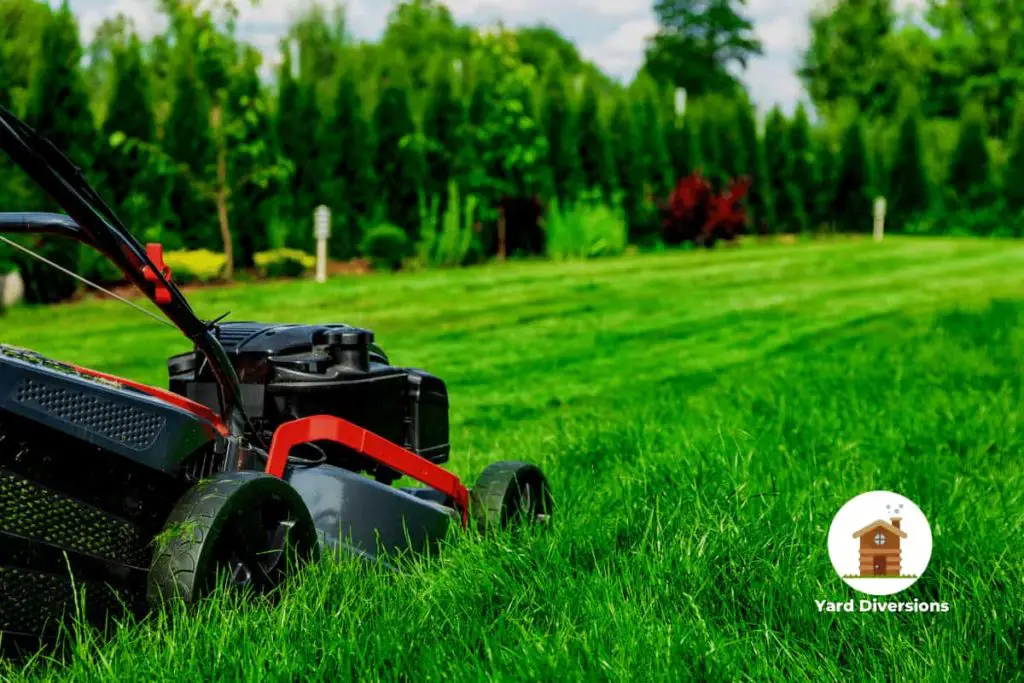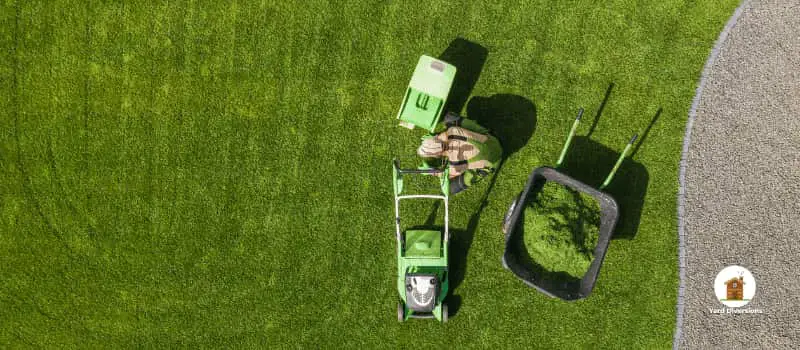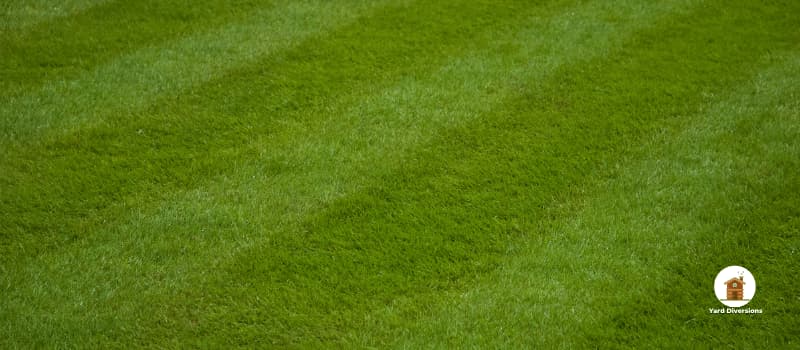If you have a lawn, backyard, or a piece of grassy land, then mowing season is something you need to be aware of. But what is the mowing season?
In simple terms, it’s the time of the year when you need to or should cut your grass as part of essential lawn or backyard maintenance.
Usually, grass grows faster when they get full sun in the daytime. The preferable air temperature will be around 60-75 degrees Fahrenheit. At the same time, the soil temperature must be 50-65 degrees Fahrenheit. Such conditions are found in the spring and summertime. So, these two are the mowing seasons.
For most areas, that would mean the season starts in March and continues through August. If your area has a warmer climate, you may also need to mow your lawn during the Autumn.

How Long Is The Mowing Season?
The mowing season is around 6-7 months long for the areas with a cool climate. You may need to mow the lawn or backyard for a few more months in warmer locations.
This means the mowing season for these areas can start from March and continue up to October.
The equation is simple. You have to cut the grass during spring and summer. Following that, if your area experiences relatively warm autumn, mowing will continue during those months as well.
You may need to mow in a hot area even in the first few days of the winter. Here’s a breakdown of the whole season.
When Does Mowing Season Start?
The mowing season starts in Spring. Usually, after passing the first one or two weeks of Spring, all the signs of winter begin to disappear. You will see that your lawn is starting to get thicker and greener.
This means the year’s first growth has begun. That’s when you should pull out your lawn mower and get ready for the first cut.
For most areas, this means the second or third week of March. However, in other colder places mowing season can start as late as April.
In short, March, April, and May are Spring in most areas, and that is when you will do the first mowing of the year.
At the beginning of the season, the grass will grow slowly. But as the temperature gets warmer and the sun shines more intensely with each passing day, the growth rate increases dramatically.
Rainfall also plays an important role. Consider the following during your first cut.
When To Cut
You can choose any date in the second week of March that hasn’t seen any rainfall in the past three days. Also, mow your grass after a few hours, when the sun has risen.
In other words, don’t run your mower on wet grass as this will seriously affect the health of the grass in the coming days.
Equipment
You don’t want to wreak havoc with your first cut. The grass hasn’t seen any action in a while. So, naturally, they will be somewhat sensitive.
Therefore, avoid using a heavy roller on the grass. The best equipment for a first cut is a lightweight four-wheeled mower.
Frequency
In March and April, you can mow your lawn once every two weeks. After that, the temperature starts to get warmer. So, in May, you will need to mow once every week.
Lowly maintained lawns or a backyard can get a single first cut in March. Then, in April and May, you can cut every two weeks.
Grass Height
Keep the size of your grass around 30-40mm during the year’s first cut. You will use the mower after a break.
So, ensure it is properly working before putting it on the grass. Needless to say, you will want to use a new and sharp blade.
You can gradually decrease the grass height to a minimum of 25mm during the subsequent mowing sessions in Spring.
Going lower than this will result in the exposure of the grass stems (this is called scalping). So, better to have a longer lawn than a damaged one.

Mowing The Lawn In Summer
If you ask, what is the mowing season, some people might answer that it’s the summer season. That’s because the first few weeks of summer are the busiest of the mowing season.
In most areas, summer starts around July and continues till the end of August. Let’s see how you will cut your grass during this period.
In June, Spring had ended. So, you won’t see the new growth spurt, which is a trademark of the season. Instead, the grass will keep growing at a steady and consistent rate.
However, if there is a lack of rainfall in August, the growth will likely slow down. Also, the grass will look dry and colorless during this time.
Equipment
In the Spring, if you cut fresh grass with the mower, it can wear down the blade pretty fast. So, it is best to start the summer with a sharpened blade.
You may also want to check the mower for servicing needs. You can use heavy rollers in this part of the mowing season.
Frequency
The months of summer see consistent and steady growth. Therefore, it’s the busiest time of the mowing season. You will want to cut the grass every week.
Sometimes you might need to change the routine for rain. As before, don’t run the mower on wet grass.
Grass Height
The warmer temperature helps the grass to recover and grow quickly. You can take advantage of this and reduce the size of your grass from 25 to 20 mm.
However, the 25-30mm range is still the perfect and healthy height for your lawn grass.
When Does Mowing Season End?
In most areas, the mowing season ends during the final weeks of Autumn. However, in some warmer regions, you may need to continue mowing in the first few days of winter.
In most areas, summer ends in August. The following September, October, and November constitute Autumn. You will notice that, as summer ends, the grass starts to grow rapidly.
The decline begins in late September and becomes noticeable in early October. In most areas, October is usually the last month you will mow your lawn.
Equipment
You have been using the heavy roller in summer. Well, September is the time to put it back in the shack. For best results and grass health, use the lightweight four-wheel lawn mower.
Frequency
You can continue your weekly mowing all through September and then when the growth is visibly declining in October, mow your lawn once every two weeks. After that, you can do one final cut in November.
For low-maintenance lawns, you can start the two weeks routine in September and do the final one in October.
Grass Height
As growth declines, the grass cannot recover quickly from damage. So, keep your grass height within the 30-40mm range.
Mowing The Lawn During Winter
The grass doesn’t noticeably grow in the winter. Plus, the ground is wet most of the time or frozen. So, lawn mowing is not essential in the winter.
However, you can pull out your mower on the finer or sunnier winter days and do a quick run. This will significantly contribute to the health of your lawn or backyard.
In the winter, lawn mowing doesn’t have to be as extensive as the mowing season. So, keep it limited to once in December and do only a quick trimming.
Keep your grass height at 40mm and not any less. Also, collect the dry fallen leaves to preserve the health of the surface.
You won’t be doing any cutting in January and February.

Best Time Of The Day For Lawn Mowing
Creating a lawn mowing routine is important if you happen to have a lawn in your house. The time of day you mow the lawn is one important factor to consider when creating a plan for lawn mowing.
Early morning (6 am – 8 am)
If you leave the bed before sunrise, you might want to mow your lawn first thing in the morning. It looks like an excellent alternative to typical warm-up workouts in the morning.
Plus, you may think getting it out of the way early in the morning will give you time for other activities.
However, this is possibly one of the worst things you could do to your grass as mowing the lawn in the earliest hours of the morning is a bad idea, and you should not do it.
Your grass is most likely to be wet due to dew or rain from the night before. And you might already know that mowing on wet grass is very unhealthy.
It will tear your grass instead of cutting it and damage the soil too. Moreover, mowing on damp ground will significantly damage your mower.
So, avoid early mornings.
After Sun Rise (8–10 am)
In the mowing season, the time between eight to ten in the morning is probably the best time to cut your grass. First of all, the sun has been up for a while. So, the ground is free from most of the moisture.
Secondly, after you are done cutting, the grass will get proper time to heal. This is because daytime provides the appropriate healing environment for the grass.
This also means that you have to schedule your lawn mowing sessions on weekends. Except for the retirees, most people have to catch work during those hours.
During High Noon (12–2 pm)
The high noon is not the best time to cut your grass. This is the time of the day when the sun is at its hottest. So, the intense temperature and heat can severely damage the freshly cut grass.
Plus, mowing the lawn in that kind of heat is punishing for you too. You will sweat a lot and lose the energy you would have needed for the rest of the day.
Another problem is equipment damage. The mower can get too hot in the sun and start malfunctioning. Not to mention, it can cause you a burn injury.
However, keep your cut short if you can’t avoid the midday mowing at any cost. Only mow the top third.
That way, you will limit sun damage to your grass.
Late afternoon (4–6 pm)
The 8–10 am window is the best time of the day to mow your lawn. But if you miss that somehow, the second best option is late afternoon.
During these hours, the conditions are close to that of the morning. The temperature might still be somewhat high, but the sun has become much friendlier for the grass.
Mowing your lawn in the afternoon also gives the grass adequate healing time before Evening falls. As the weather is still warm, ensure you are adequately hydrated when cutting your grass.
Mowing After Evening (6–8 pm)
You might be tempted to trim the lawn in the Evening. That’s because you will have all your day’s work at this hour. Plus, mowing the lawn in the Evening is comfortable too.
There is no scorching sun to make you sweat and burn. However, cutting in the Evening is a terrible idea, and you should avoid it at all costs.
The freshly cut grass is exposed to fungal diseases when you mow the lawn after 6 pm or after dark. In the morning, the sun’s heat was there to take care of this situation.
But since there is no sun, the fungus can easily take hold of the newly cut grass. As a result, your lawn or backyard will suffer from fungal infections.
If you can somehow ensure that no fungal infection attacks your grass, there is still the question of recovery. Your grass is getting the necessary light and temperature to fill up the damage from the cut.
In short, mowing in the Evening makes your lawn overall unhealthy.
Some Tips On Cutting Your Grass
Now that you have a solid idea of what the mowing season is and what time of the day is best for mowing, here are some of the most important tips regarding mowing to make the job easier.
Length Range
The importance of length ranges can’t be over-emphasized. A shorter lawn indeed looks better. When you cut the grass very short, the whole lawn looks like one lush green carpet.
However, you will be sacrificing the health of your grass for this appearance. The lawn will quickly grow out of this look. But the damage you did can become permanent.
Grass creates food from sunlight. The process is called Photosynthesis. The part of the grass that carries out this process is the green blades.
So, when you cut it too short, it doesn’t have the necessary means of producing its food. As a result, the grass can’t recover and will mostly die.
So, ask yourself the question. Do you want to kill your lawn just to look good for a brief period?
Collecting The Clippings
When you cut the grass, the clippings accumulate on the surface. You can collect these blades of grass by attaching a collection bag to your mower.
This keeps your lawn tidy and also saves you the trouble of cleaning up after a mowing session. But should you always collect the clippings?
Well, if you are leaving enough length and the clippings are short, then you might want to leave them on the ground.
Because these fresh blades of grass are rich in nutrients. The soil can easily absorb them and turn them into fertilization for the growing grass.
On the other hand, if the clippings are too long, then you need to collect them. Longer blades of grass are hard to absorb.
So, they will clog the ground instead of providing nutrients and hamper your lawn’s growth.
Try Different Directions
Lawn mowing is a chore. And people often tend to complete their chores almost robotically. So, you might grow a habit of mowing the lawn from one set direction every time. However, this can destroy the appearance of your lawn.
When you mow in the same exact direction every session, the grass blades also become habituated to it.
As a result, the new blades grow at that specific angle instead of growing upright. Plus, the mower will create permanent tracks on the lawn when you keep running it in the same direction.
So, each time you mow the lawn, do it from a different direction. This will ensure the grass doesn’t get accustomed to one specific angle.
As a result, you can maintain a nice upright professional-looking lawn.
How Does Yard Work, Such as Mowing, Impact the Health of the Lawn during Mowing Season?
During mowing season, completing yard work regularly can positively impact the health of the lawn. Following a complete yard work guide, including mowing, fertilizing, and proper watering, will help maintain a lush and healthy lawn. Consistent maintenance is essential for promoting strong, vibrant grass throughout the mowing season.
Conclusion
So, what is lawn mowing season? How long is the lawn mowing season? And when does it start and end? Hopefully, you have found the answers to all of these.
Make sure to mow on a dry lawn when the sun is up with a sharp blade and avoid cutting your grass too short, voila! You will have a healthy, professional-looking lawn all year round.
Hope this helps and thanks for stopping by.

